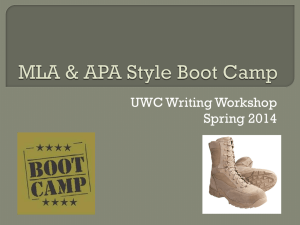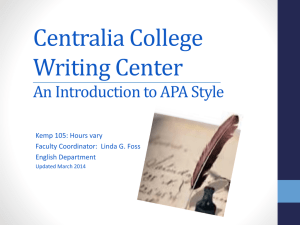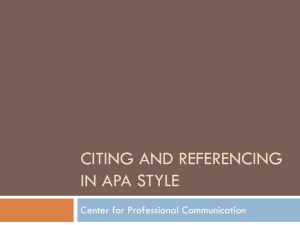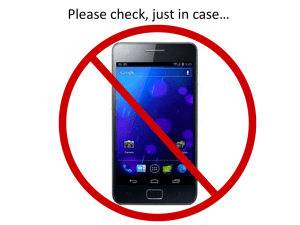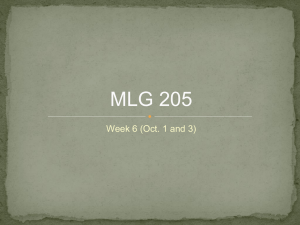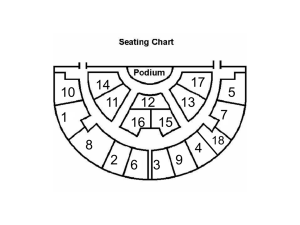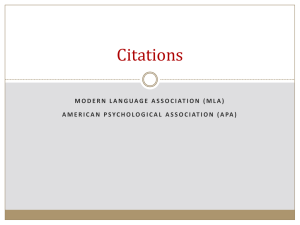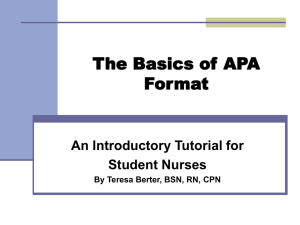APA Tutorial
advertisement
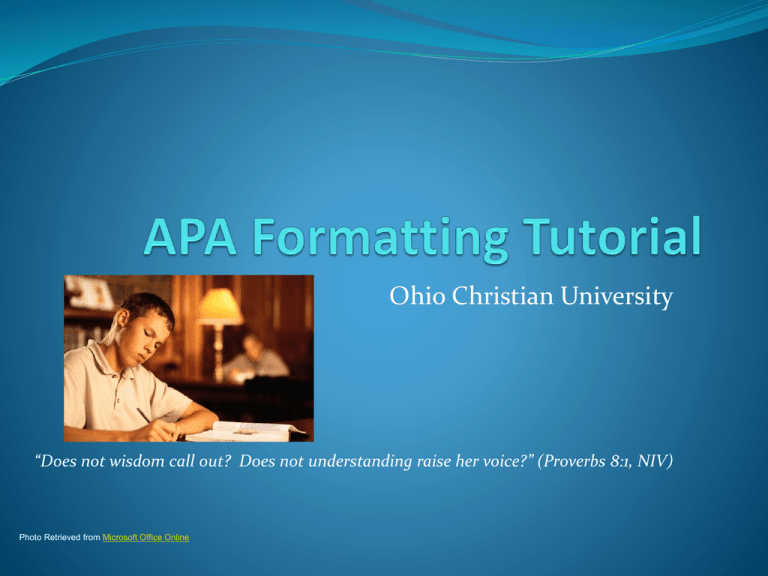
Ohio Christian University “Does not wisdom call out? Does not understanding raise her voice?” (Proverbs 8:1, NIV) Photo Retrieved from Microsoft Office Online What is APA? APA stands for American Psychological Association. It is a writing format, developed by that association, for organizing information in a term paper, thesis, or essay. APA guidelines show how to cite (give credit to) or document information within the body of a paper that was directly quoted, summarized, or paraphrased from a source. It is also used for citing facts, statistics, and visuals. Photo retrieved from Microsoft Office Online APA Papers OCU requires APA format for all written assignments. This is common with many colleges and universities across the country. APA is discussed in detail on pages 457-501 of Diana Hacker’s (2010) A Writer’s Reference with Exercises (6th Edition). The contents of this tutorial are based primarily on that book, the required grammar guide for Ohio Christian University students. Photo Retrieved from Microsoft Office Online Developing the Paper Title Page Let’s start with the title page. Turn to page 493 in the Hacker (2010) text for an example of a title page. However, Ohio Christian University has a standard title page for all students to use with papers. If you do not have this, contact your facilitator or the Student Services Coordinator (Michelle Blanton mblanton@ohiochristian.edu) to obtain one. Office Online Photo Retrieved from Microsoft Abstract Turn to page 494 in the Hacker (2010) text for an example of an abstract. An abstract is basically an overview or summary of your term paper/essay. It appears directly after the title page. It should be around100-120 words in length with no indentation. Most of OCU’s courses do not require students to include an abstract in their assignments because they are undergraduate courses. However, it is important to know what an abstract is because it is usually found in professional writings such as journal/periodical articles, master’s theses, and doctoral dissertations. Photo Retrieved from Microsoft Office Online APA Paper Elements All the elements of an APA paper include: The title page (see previous) The body of a paper, which includes: an introduction, section headings, and a conclusion. References Photo retrieved from Microsoft Office Online Note: Sources quoted from or referred to in the body of the paper must be cited according to APA guidelines. See pages 493-501 in the Hacker (2010) for an example of an APA paper. You may also go to http://bcs.bedfordstmartins.com/writersref6e/Player/Pages/Main.aspx Click on Model Papers, scroll to APA Papers, and download: Mirano’s “Can Medication Cure Obesity in Children? A Review of the Literature” (alternative undergraduate formatting) Formatting the Paper • Double-space between lines, including block quotes and references. • There should only be one space after each punctuation mark. • Use one inch margins around your paper. • The left margin should be even. • The right margin should be ragged or uneven. • Words are not to be divided between lines. See pages 489-492 in the Hacker text (2010) for formatting details and more expectations. Photo Retrieved from Microsoft Office Online Section Headings See pages 498-499 in the Hacker (2010) text for an example of section headings . Page 490 in the Hacker text (2010) tells us that the first heading level is typically enough in undergraduate writing. Utilizing section headings helps organize your written assignments. It also enables your instructor to move through your paper more easily and efficiently. Photo Retrieved from Microsoft Office Online Long (Block) Quotes See the top of page 465 for an example and page 490 for expectations in the Hacker (2010) text. Block quotes: • Are often used when a writer feels that a lengthy quote adds to his or her paper. However, like any quote, be careful to use them sparingly. • Consists of 40 words or more. • Are introduced with a signal phrase and are started on a new line. • Are indented ½ inch from the left margin of your paper. • Are double-spaced. • Quotation marks are not used around this type of quote, but double quotation marks are used for any quote within a block quote. • The citation appears after the block quote. It is not included within the last sentence of a quote as with shorter quotes. Including Visuals in APA Papers See page 497 in the Hacker (2010) Text for an example of a Table 1. Occasionally there will be a need to include a visual in your APA paper. These include: • • • • • • Tables Figures Photos Charts Graphs Drawings Photos Retrieved from Microsoft Office Online Guidelines for Including Visuals Page 490 in the Hacker (2010) text gives some general guidelines for visuals. • Visuals should be simple (condense information). • Each visual should be labeled with an arabic numeral (i.e., Figure 1, Figure 2, Figure 3). • Include a title for each visual. • Indicate the source below the visual. • Discuss or give an overview of the visual within the text/body of your paper. Citations (in-text) Citations vs. References These two terms are often confused. So what’s the difference? “An in-text citation gives the author of the source (often a signal phrase), the date of publication, and at times a page number in parentheses. At the end of the paper, a list of references provides publication information about the source” (Hacker, 2010, p. 469). In-text citation example (used only in the body of the paper): As researchers Yanovski and Yanovski (2002) have explained, obesity was once considered “either a moral failing or evidence of underlying psychopathology” (p. 592). Reference example (used only in a reference list at the end of a paper): Yanovski, S.Z., & Yanovski, J.A. (2002). Durg therapy: Obesity. The New England Journal of Medicine, 346, 591-602. Citations APA utilizes in-text citations for documenting (giving credit to) authors for their works. The Hacker (2010) text gives examples of citations for different types of sources. These appear on pages 470-473. Citations consist of: A signal phrase. Includes the author’s last name and publication date in parentheses. The page number appears (also in parentheses) at the end of a quote. Page numbers are not needed when summarizing or paraphrasing information, but are often used. Citation Example Example: Signal Phrase According to Johnson and Johnson (2006), “A group may be defined as a number of individuals who join together to achieve a goal” (p. 5). The period goes after the citation at the end of a sentence unless you have used a block quote. Note: Use “pp.” when more than one page is listed in a citation. Use “n.d.” when a publication date is not given. More on Signal Phrases Photo Retrieved from Microsoft Office Online “APA requires that the use of the past tense or the present perfect tense in signal phrases introducing cited material” (Hacker, 2010, p. 469). Signal Phrase Example: In his study on adult learning Adams (2008) indicated … Note: Use all quotes sparingly. Summarize or write in your own words as much information as possible in your papers. Citations for Internet Sources Note: Internet citations are done a little differently from citations from hard copy sources. They usually include the section name and paragraph number. (The symbol ¶ or the abbreviation “para” is used in those citations.) Example of an Internet Citation: (Jones, 2007, Overseas Ministry section, para. 4) OR (Jones, 2007, Overseas Ministry section, ¶ 4) Brackets within Quotations “Brackets (square parentheses) allow you to insert your own words into quoted material to explain a confusing reference or to keep a sentence grammatical in your context” (Hacker, 2010, p. 464). [ ] Brackets are also used to indicate an error within a quotation from a source. The letters sic (in italics) enclosed in brackets are placed next to that error. [sic] Example: The hymn was writtin [sic] well over two hundred years ago. The Ellipsis Mark ... From time to time you will come across a quote you want to use, but feel it is much longer than you need for your paper. “To condense a quoted passage, you can use the ellipsis mark (three periods, with spaces between) to indicate that you have omitted words. What remains must be grammatically complete” (Hacker, 2010, p. 464). Personal Communications See page 472 in the Hacker (2010) text. Personal communication citations are used for: • • • • Interviews (Face-to-face or via telephone) E-mails Memos Letters Note: Personal communications are not included on the reference page. Example of an In-Text Personal Communication Citation: (P. Hanson, personal communication, December 5, 2008) Photo retrieved from Microsoft Office Online Indirect Sources Sometimes you will use information in your paper that comes from a secondary source. In other words, one author quoted or summarized the works of another author and included that information in his or her work. In that case, the citation is done a little differently. • The original source should appear in the signal phrase. • The citation will include the secondary source. The secondary source should appear on your reference page (Hacker, 2010, p. 473) Example Citation for Indirect Sources Paul Hersey and Kenneth Blanchard (1977) developed the theory of Situational Leadership. They concluded from their study at Ohio State University “that most leadership activities can be classified into two distinct behavioral dimensions: initiation of structure (task actions) and consideration of group members (relationship of maintenance actions)” (as cited in Johnson & Johnson, 2006, p. 197). However, you would need to find the reference information for Hersey and Blanchard and include it in your Reference Page. This is surprisingly easy using Amazon and Google Books. References (Reference Page) References Any time information is cited within a body of a paper, a reference must be listed for that source on the reference page (s). See pages 475-481 in the Hacker (2010) text for examples of physical references. Photo Retrieved from Microsoft Office Online Review pages 475-481 to properly reference: • Books • Journal/Periodical Articles • Popular Magazine Articles • Government Documents Example of an APA Reference Blanchard, K., & Hodges, P. (2005). Lead like Jesus: Lessons from the greatest leadership role model of all time. Nashville, TN: Thomas Nelson, Inc. Note: Initials are used for the first and middle names of the authors. The publication date goes next to the author’s/authors’ name(s). The book title is in italics. Only the first word and all proper nouns are capitalized in a title or subtitle. Use a hanging indent with your references. Alphabetize references according to the authors. Double-space individual references. Include the city and state where a resource was published. References for Electronic Sources See pages 481-485 in the Hacker (2010) text for examples of Internet references. Internet or electronic references are a little different from other references. The date of retrieval and the Uniform Resource Locator (URL) are often included in them. The URL will the lead reader to the exact location where the information was found on the internet. Note: While the web is a great place to find information for a paper, the disadvantage of using an electronic source is that web sites often change their information and some sources are only available for a certain period of time. Example of an Electronic Reference Alimo-Metcalfe, B., & Ablan-Metcalfe, J. (2005). Leadership: Time for a new direction? Leadership Research & Development Ltd, 1, 5171. Retrieved May 2005, from http://lea.sagepub.com/cgi/reprint/1/1/51 Writing Academically Writing Mechanics The Hacker (2010) provides a nutshell for all the essential aspects required of an excellently prepared academic paper. Please observe the breakdown of the book below and utilize often as you write. 1. 2. 3. 4. 5. Composition and Style: pages 3-174 Correctness: pages 177-355 Academic Research: pages 359-394 APA Formatting: pages 457-501 Overview of Basic Grammar: pages 533-556 Other Resources Amato, C. J. (2002). The world’s easiest guide to using the APA: A friendly Manual for formatting research papers according to the American Psychological Association style guide (3rd ed.). Corona, CA: Stargazer Publishing Company. American Psychological Association. (2001). Publication manual of the American Psychological Association (5th ed.). Washington, DC: Author. Purdue University APA Format Information http://owl.english.purdue.edu/workshops/hypertext/apa/index.html American Psychological Association http://www.apastyle.org/pubmanual.html Don’t be afraid to ask questions! If you have questions on any of the APA Guidelines or writing mechanics, please don’t hesitate to ask your instructor. We are here to help! Photo Retrieved from Microsoft Office Online For “we are God’s fellow workers…” (1 Corinthians 3: 9, NIV). American Psychological Association. (2001). Publication manual of the American Psychological Association (5th ed.). Washington, DC: Author. Blanchard, K., & Hodges, P. (2005). Lead like Jesus: Lessons from the greatest leadership role model of all time. Nashville, TN: Thomas Nelson, Inc. Hacker, D. (2010). A writer’s reference with exercises (6th ed.). Boston, MA: Bedford/St. Martins. Johnson, D. W., & Johnson, F. P. (2006). Joining together: Group theory and group skills. Boston: Pearson/Allyn and Bacon. Photos Retrieved from Microsoft Office Online

